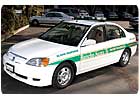
Gasoline-electric hybrid autos are used in the patrol fleet of Rancho Santa Fe Protective Services, Encinitas, Calif., in shifts practically 24 hours per day, which can strain their variable speed transmissions, thinks Denise Mueller, CEO, because they never have a chance to cool down. But that is her only reservation about the cars, and she appreciates their gasoline savings.
In 2003, when gasoline-electric hybrid autos were first becoming available, Denise Mueller, CEO of Rancho Santa Fe Protective Services, Encinitas, Calif., thought using them as patrol vehicles would reduce costs, (see “Patrol With Less Petrol,” SDM, March 2005, p. 54). At the time, gasoline prices were climbing toward $2.30/gallon in her area around San Diego.
At that time, she calculated a net difference of $0.14 per mile savings for each hybrid mile driven. At 266,500 miles, the savings totaled approximately $37,310 over the year, or $3,109 per month of gas savings.
Those calculations were made before gasoline prices skyrocketed during the summer of 2006 to more than $3.00 a gallon in her area. “Moving to an average 33 to 35 mpg has really helped us, especially with gasoline prices,” she remarked.
She has had up to 10 autos in her patrol fleet that were hybrids. Currently, nine are in use. Of those, two have been driven more than 200,000 miles and two more have more than 170,000 miles on them. The one that was taken out of service after being totaled had 186,000 miles on it, she said.
Hybrid autos run on a small gasoline engine and an electric engine. Electricity from a supplemental battery drives the electric motor, which provides extra power to the gasoline motor for acceleration.
The supplemental battery is recharged automatically when the vehicle is driven and when the brakes are applied. Hybrid vehicles never have to be recharged when idle. The two motors operate together seamlessly without any driver intervention.
The supplemental battery packs were warranteed for 80,000 miles, but none have needed replacement, even with mileages nearly three times that distance.
“The only major issue has been the transmissions,” she declared. “They are more expensive than a regular transmission, since they are a belt transmission, but they have gone out at the same mileage as our old Crown Vics used to go out — around 80,000 to 100,000 miles — so they are just a bit more expensive to fix when they do go out.”
Ironically, the success of the Honda hybrids have made them harder to obtain, so she has had to replace them with gasoline Honda Civics when hybrids were unavailable. But the gasoline Civics still obtain high enough mileage for significant savings and cost approximately $5,000 less than hybrids, she calculated.
“We have had great success with them,” she said of the hybrids.